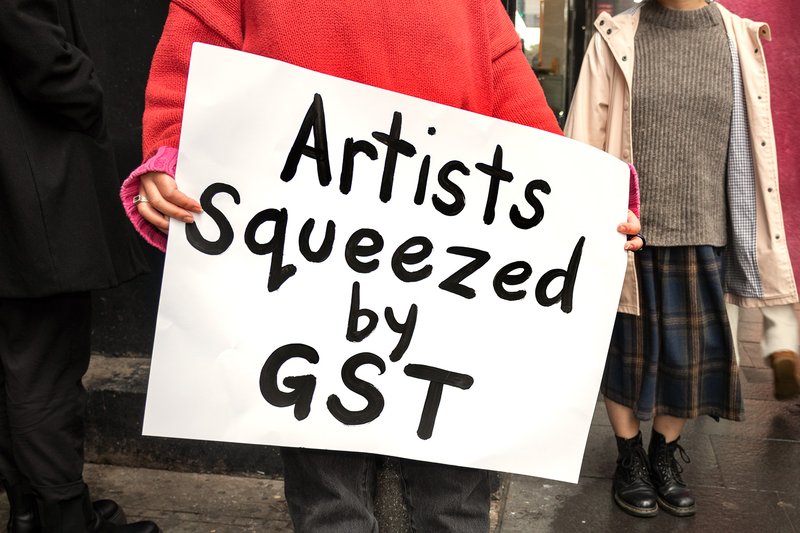GST hits artists harder than most
The arts sector is pushing for urgent tax reforms, including changes to GST and HECS/HELP repayments, to protect artists from being pushed into debt by a single successful year.
The arts sector is pushing for urgent tax reforms, including changes to GST and HECS/HELP repayments, to protect artists from being pushed into debt by a single successful year.

The NSW Government’s consultation on The Art of Tax Reform has now closed. More than 120 submissions have already been published on the NSW Government’s What We Heard page, with more expected to be added in the coming weeks. These include contributions from individual artists, arts organisations, and peak bodies, putting forward ideas to make the tax system better for artists and the sector.
NAVA’s submission called for long-overdue reforms, including tax exemptions on prize money and grants, and exempting artists from the non-commercial losses rules. Another one of the issues we raised was the way artists are squeezed by GST.
Throsby reports that more than a quarter of visual artists earn under $10,000 annually from their practice, and RMIT research shows over 80% earn less than $25,000. Australian Business Number (ABN) registration data (2020) also shows that 76% of creative industry sole traders are not GST registered, and in the visual and performing arts the figure is even higher at 91%. Many artists operate well below the GST threshold of $75,000 a year. But in some years, a single art prize, commission, or spike in artwork sales can temporarily push an artist over the line.
Under current rules, if an artist exceeds the threshold, they are required to register for GST. This is a heavy administrative and financial load for sole traders with irregular income. Worse still, if an artist goes over the GST threshold but hasn’t added GST to their invoices, they are still liable to pay it. This means they can find themselves owing thousands in unexpected back-payments.
If an artist’s income falls back below the threshold, artists are not automatically released from GST. They must apply to the ATO to cancel their registration, usually after being registered for at least twelve months, or by showing that turnover will remain under the limit. The application must be lodged within 21 days, and the ATO may ask for projections of future earnings.
Even for artists earning below the GST threshold, GST is still a cost they can’t avoid. Because they’re not registered, they can’t claim back GST on expenses like studio rent, gallery hire, or materials. This means artists often end up paying hundreds or even thousands of dollars in GST, with no way to recover it in the way other small businesses can. NAVA recommends introducing GST exemptions for studio and gallery leases where artists and creative tenants are not GST-registered. This would directly address one of the most persistent inequities facing artists and reduce a key driver of unrecoverable debt.
We also support other ideas raised in submissions, such as property tax exemptions for landlords who lease to artists and cultural workers (on the condition that the savings are passed on through lower rent), and targeted GST exemptions for creative tenants earning below the registration threshold.
NAVA is also calling for a GST threshold averaging system, where liability only applies if an artist’s income averages above $75,000 over five years. This would smooth out the impact of one-off high-earning years.
The pressure is compounded when a one-off income spike also results in compulsory HECS/HELP repayments. One artist told us that a single year of strong sales forced them to register for GST and repay their entire HECS debt, leaving them with a $30,000 bill to the ATO. They had to go on a payment plan to manage this, even though their income dropped back below the threshold the following year. One good year should not push artists into years of debt.
NAVA has recommended HECS/HELP repayments be calculated on at least two years’ average income, with the option to defer or reduce repayments in years of hardship.
Reforming GST and HECS/HELP together would protect artists from disproportionate financial shocks that can wipe out the gains of an entire year. For many artists, a single prize or commission doesn’t feel like a windfall - it sparks sudden tax bills, unexpected GST back-payments, and/or compulsory HECS repayments. The result is often debt, payment plans, and financial stress, rather than the stability to keep making work.
NAVA will be attending The Art of Tax Reform Summit in late September. This invitation-only event brings together representatives from across the arts, as well as philanthropy, academics, tax professionals and the commercial sector to look for ways to address the industry’s challenges through tax reform.
NAVA will continue to push for reforms that address the precarity of artists’ incomes.
To strengthen this case, we need more evidence of how surprise tax debts are affecting artists. If you’ve faced unexpected ATO bills after a one-off good year, we encourage you to share your experience with us.
These stories are critical in demonstrating the scale of the problem and the urgency of reform. We also welcome other tax-related case studies, from GST to super, income averaging or HECS/HELP, so that we can build a clearer picture of how tax settings are affecting artists’ lives and practices.
Please email us at nava@visualarts.net.au
Photo by Garry Trinh.
ID: A person wearing a red jumper holds a handmade protest sign that reads, “Artists Squeezed by GST” in large black letters.